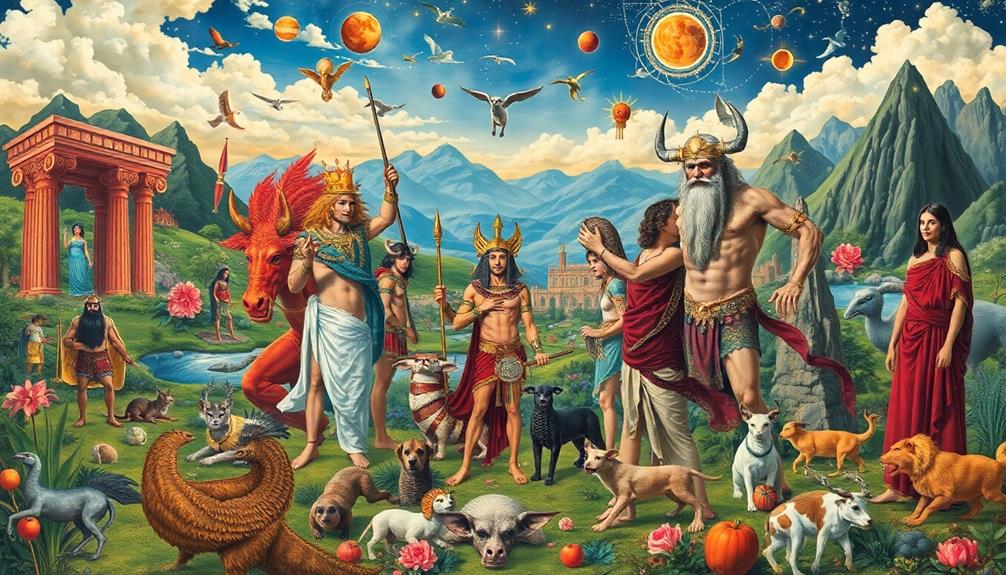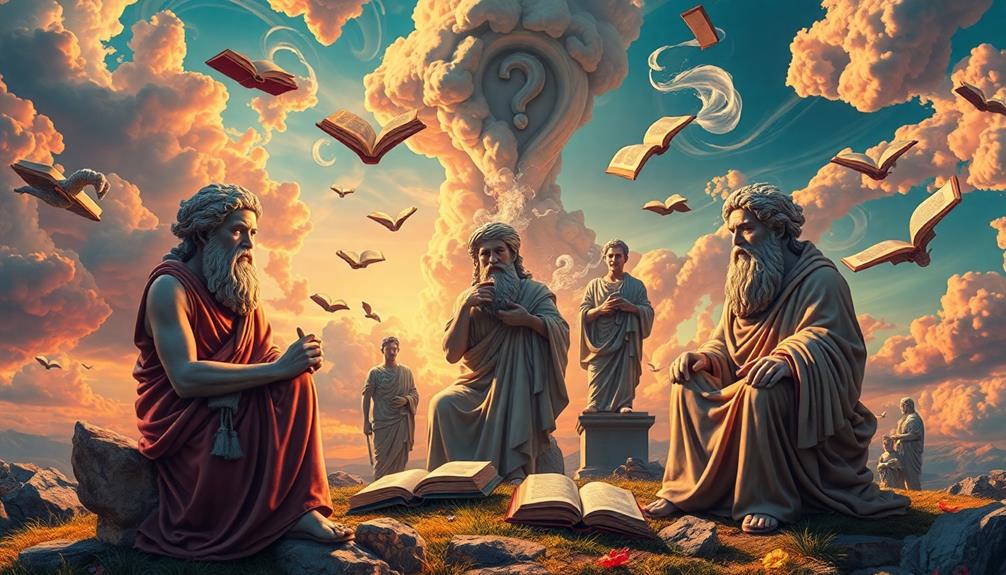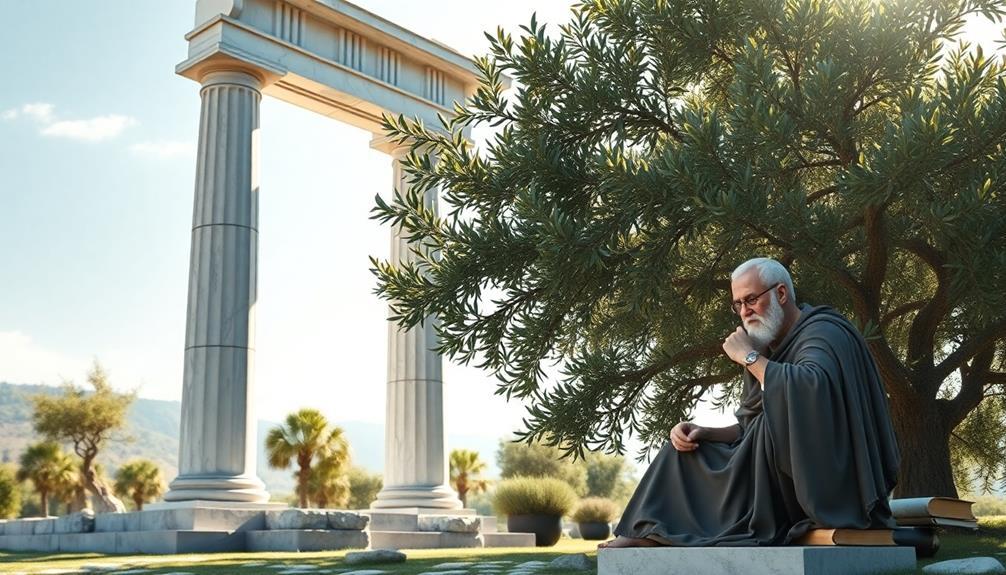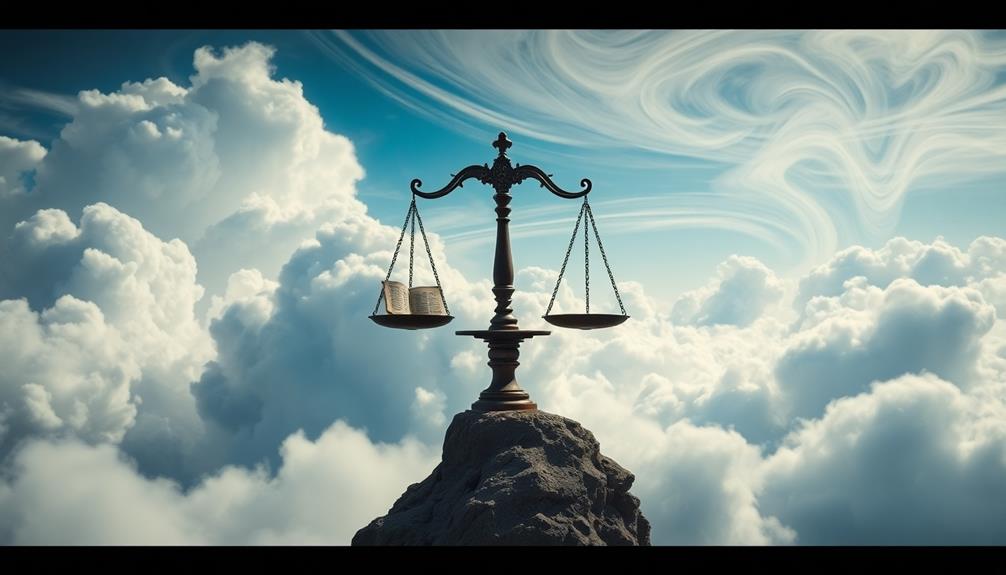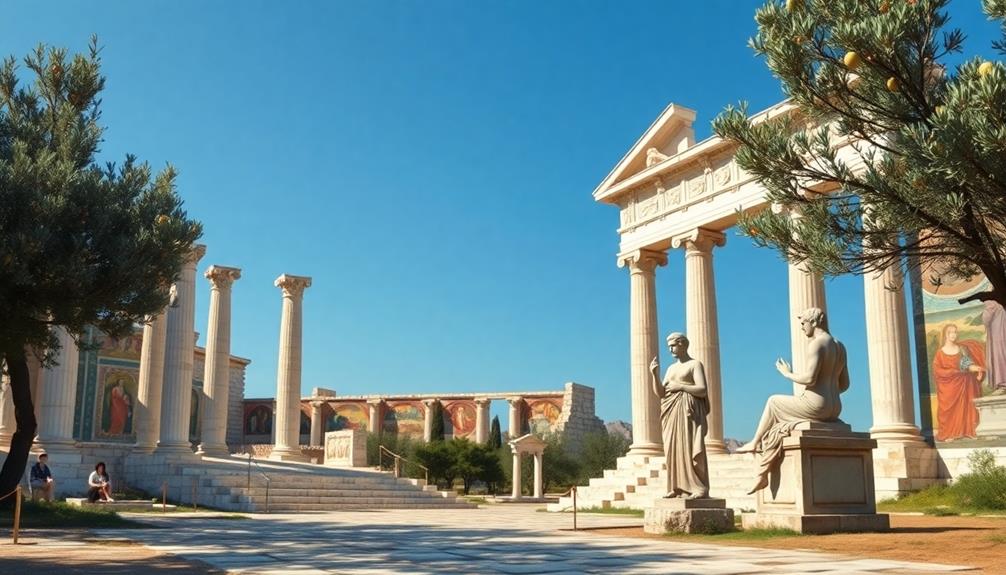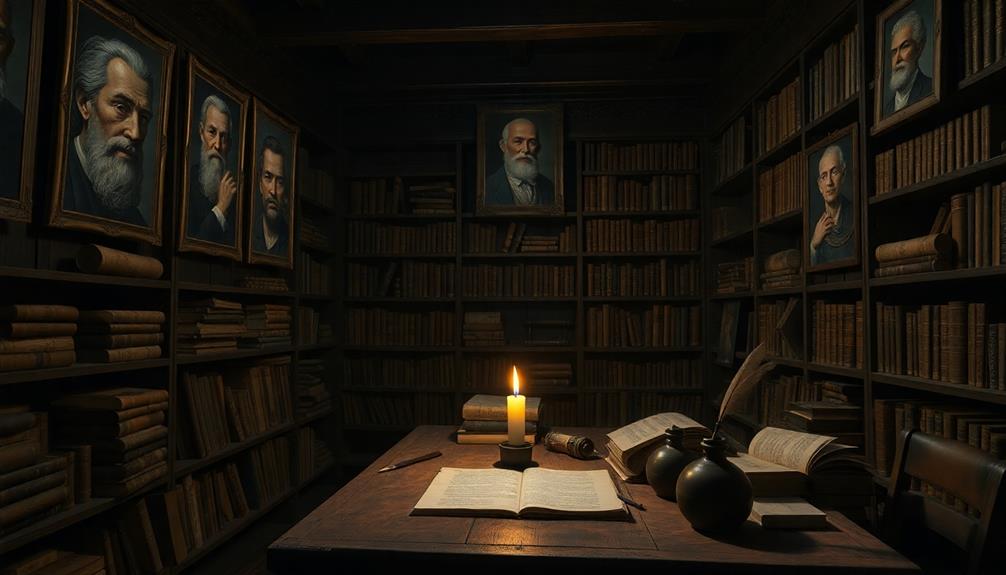You'll find that Greek myths share shocking similarities with other cultures, highlighting universal themes that resonate widely. For example, creation myths often depict a divine craftsman bringing order from chaos. In both Greek and Hindu traditions, powerful deities oversee cosmic order, while heroic journeys showcase common archetypes and transformative trials. Love and desire connect characters in tales across cultures, and afterlife beliefs reflect shared concepts of judgment and reward. Even moral lessons imparted through myth teach significant life values. These parallels reveal deep cultural exchanges, hinting that the human experience is intricately connected. More connections await your exploration.
Key Takeaways
- Creation myths across cultures often depict a divine craftsman bringing order from chaos, highlighting shared themes of origin and divine authority.
- Divine beings in Greek and Hindu myths, like Zeus and Indra, govern cosmic order and influence human lives through their powerful roles.
- Heroic journeys feature common archetypes, emphasizing personal growth through trials and challenges faced by heroes in various mythologies.
- Love deities such as Eros and Manmadha illustrate the complexities of desire and relationships, reflecting similar cultural significance across traditions.
- Afterlife beliefs, including judgment and rituals for the dead, reveal parallels between Greek and Hindu perspectives on mortality and the afterlife.
Creation Myths Across Cultures
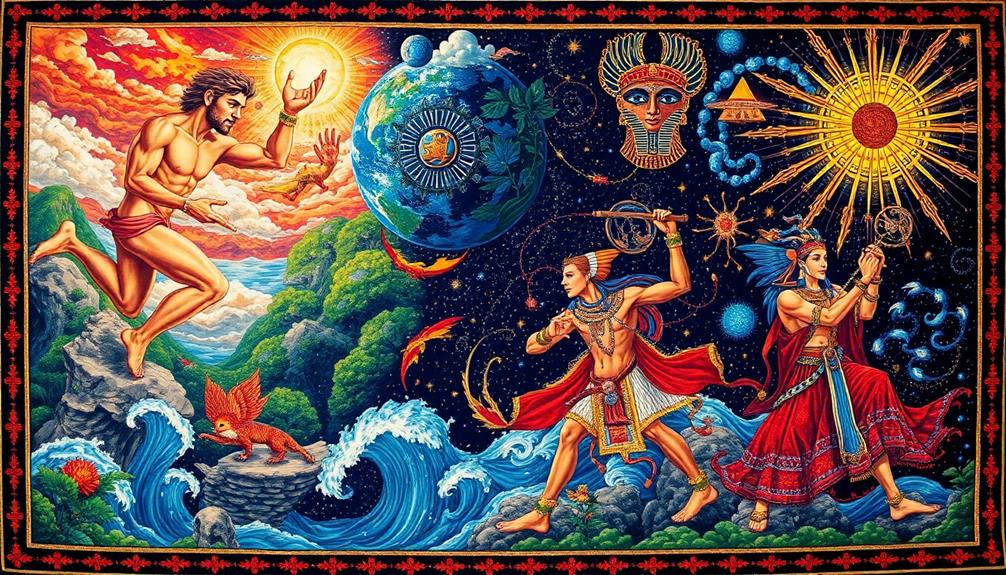
Creation myths across cultures reveal humanity's shared quest to understand its origins. In stories like Genesis and Greek cosmogony, you'll notice a common theme of creating order from primordial chaos. A divine craftsman or deity typically initiates this process, highlighting how various cultures interpret the creation of man.
For instance, both Genesis 1 and Plato's Timaeus emphasize creation through rational speech, suggesting a philosophical approach to existence.
The Garden of Eden and Greek agrarian utopias illustrate a paradisiacal setting, showcasing similar ideals across different narratives. When you examine the creation of woman from man in Genesis, it echoes patterns found in Greek mythology, which often explains human relationships and societal roles.
These narratives serve to clarify not just our beginnings but also our connections to one another.
Additionally, themes of disobedience, like the forbidden tree in Genesis, resonate with Greek myths that investigate divine tests and the consequences of human actions.
Divine Beings and Their Roles

Divine beings across various cultures play essential roles in shaping the universe and human experience. In Hinduism, the supreme triad of deities—Brahma, Vishnu, and Maheshwara—parallels the Greek pantheon of Zeus, Poseidon, and Hades, each representing significant aspects of creation, preservation, and destruction.
These divine beings not only govern cosmic order but also influence human lives through their actions. This concept of divine influence can also be seen in the way the tea industry focuses on sustainability, highlighting the interconnectedness of nature and human endeavors.
Take Manmadha, the Hindu god of love, who's much like Eros in Greek mythology. Both wield arrows to inspire desire and affection among mortals, showcasing how divine beings connect with human emotions.
Similarly, Indra and Zeus reign over their domains with authority, associated with thunder and lightning, emphasizing their roles as powerful divine beings.
Yama, the Hindu lord of death, mirrors Hades, governing the afterlife and the fates of the deceased. Both guarantee that the cycle of life and death is maintained.
Heroic Journeys in Mythology

As you explore heroic journeys in mythology, you'll find common archetypes that shape these epic tales.
Heroes face trials and challenges that test their resolve, whether it's Odysseus battling mythical creatures or Arjuna confronting moral dilemmas.
These narratives not only highlight personal growth but also reflect universal themes of courage and perseverance.
Common Hero Archetypes
Heroic journeys are at the heart of many mythologies around the world, showcasing characters who undergo profound transformations.
You'll notice that numerous cultures share common hero archetypes, each initiating a transformative journey. Take Odysseus from Greek mythology and Rama from Hindu epics, both facing trials that test their character and resolve.
The reluctant hero is another prevalent archetype. Think of Hercules, who hesitated to accept his fate, mirroring Arjuna's struggle with duty in the Mahabharata. These characters highlight the internal conflicts heroes often face.
Guidance from mentors is essential in these stories. Athena advises Odysseus, while sage Vasishtha guides Rama, emphasizing the importance of wisdom in steering through challenges.
Moreover, the return home after a lengthy quest marks personal growth, as seen when Odysseus finally returns to Ithaca and Yudhishthira comes back to his kingdom in the Mahabharata.
Many heroic tales also include a descent into the underworld or similar domains, symbolizing the confrontation with death.
Orpheus's journey to retrieve Eurydice and Yama's domain in Hindu mythology showcase this archetype, reflecting the universal quest for knowledge and understanding.
Trials and Challenges
Numerous myths across cultures highlight the trials and challenges heroes confront on their journeys. You might notice how Greek tales, like those of Odysseus, share striking similarities with the heroic exploits found in other traditions. For instance, the twelve labors of Heracles mirror the challenges faced by figures like Krishna in Hindu mythology. Both cultures emphasize the motif of overcoming obstacles to achieve significant goals.
As you explore deeper, consider how characters like Arjuna wrestle with moral dilemmas akin to those of Achilles. These trials and challenges often test their courage, strength, and wisdom. In both Greek and Mesopotamian narratives, such as the Epic of Gilgamesh, you can see this universal theme of heroism and personal growth manifesting.
Furthermore, the guidance of divine beings plays an essential role in these journeys. Heroes like Perseus receive help from the gods, just as Rama is assisted by Hanuman in Hindu stories.
You'll find that many trials involve journeys to the underworld, showcasing a shared exploration of life, death, and the afterlife, as evidenced in the tales of Orpheus and Yama. This interconnectedness highlights the enduring nature of heroic journeys across cultures.
Themes of Love and Desire
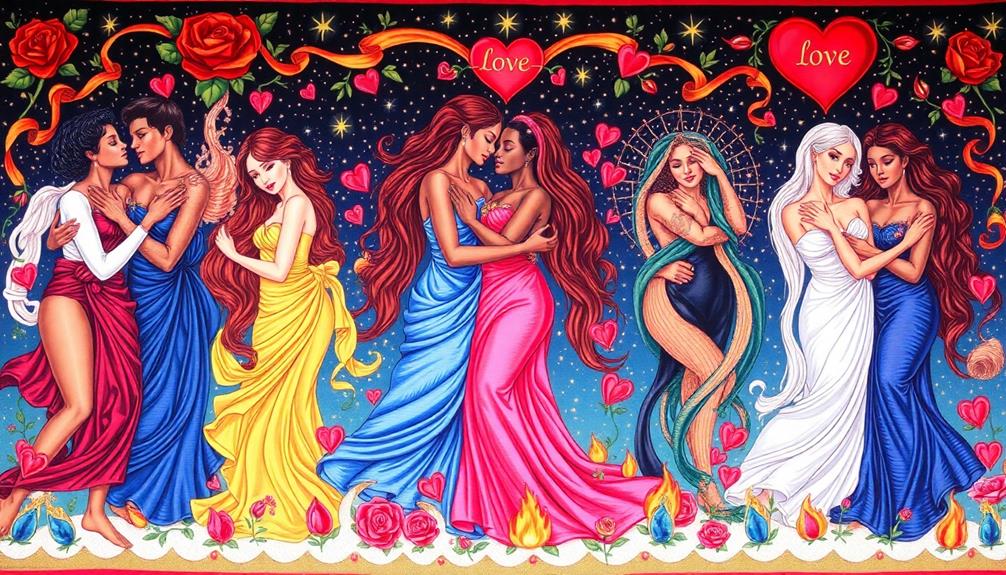
When you explore themes of love and desire, you can't help but notice the powerful love deities that appear across cultures, like Eros and Manmadha.
These figures wield arrows that spark intense emotions, reflecting the universal challenges of longing and jealousy in relationships.
Love Deities Across Cultures
Love deities, like Manmadha in Hinduism and Eros in Greek mythology, serve as powerful symbols of desire and connection across cultures. Both wield bows and arrows, invoking desire in the hearts of individuals and highlighting love's transformative power. Their narratives dive deep into themes of romance and the complexities of human relationships, showcasing universal experiences that resonate through time and geography.
In both traditions, love deities occupy central roles in myths, emphasizing the importance of love and attraction. You'll find stories that reveal how these deities influence the lives of mortals, guiding them through the intricacies of love.
The cultural significance of love deities like Manmadha and Eros extends into literature and art, where their influence shapes societal views on relationships throughout history.
These similarities in the portrayal of love deities underscore a shared human experience of love and desire. Whether in the lush landscapes of Hindu epics or the poetic verses of Greek tragedies, the essence of these deities remains a reflection of the enduring power of love across different cultures.
Exploring these connections can deepen your appreciation for the diverse expressions of desire and affection in our world.
Arrows of Desire
While the arrows of desire shot by deities like Manmadha and Eros evoke powerful emotions, they also reveal the intricate layers of romantic relationships. In both Hindu and Greek mythology, these love gods wield their arrows to ignite passion and attraction, illustrating universal themes that resonate across cultures.
You'll notice that tales of love often involve trials and tribulations, highlighting the complexities of desire and the transformative power it holds over individuals.
Both Manmadha and Eros symbolize love's dual nature—its beauty and tumult. Their stories explore how desire can lead to both ecstasy and heartache, reminding us of the unpredictable journey of love. As you explore deeper into these narratives, you'll find that the consequences of love and desire are central to understanding the human experience.
The similarities between these love deities underscore a shared cultural understanding of romance, emphasizing that the arrows of desire transcend boundaries. Their influence is reflected in various literary and artistic works, showcasing how deeply ingrained these themes are in our collective consciousness.
Ultimately, love remains a fundamental aspect of life, woven into the fabric of our stories across time and cultures.
Cultural Significance of Love
The cultural significance of love resonates deeply across civilizations, shaping art, literature, and social practices. In both Hindu and Greek traditions, love deities like Manmadha and Eros wield arrows to ignite passion and desire, emphasizing love's transformative power. These narratives reflect the trials and triumphs of romantic pursuits, illustrating a universal understanding of love's complexities.
Consider the powerful emotions evoked by love:
- The thrill of a first kiss
- The ache of unrequited affection
- The joy of a lasting union
- The heartbreak of separation
- The hope ignited by a forbidden tree
These themes resonate through ancient texts, from the Ramayana to Greek myths, showcasing the enduring importance of love in human experience. Festivals and rituals across cultures invoke these deities, seeking their blessings for marriages and romantic connections.
Love's intricate narratives teach us about longing, sacrifice, and the joys and sorrows that accompany deep emotional bonds.
Afterlife Beliefs and Practices
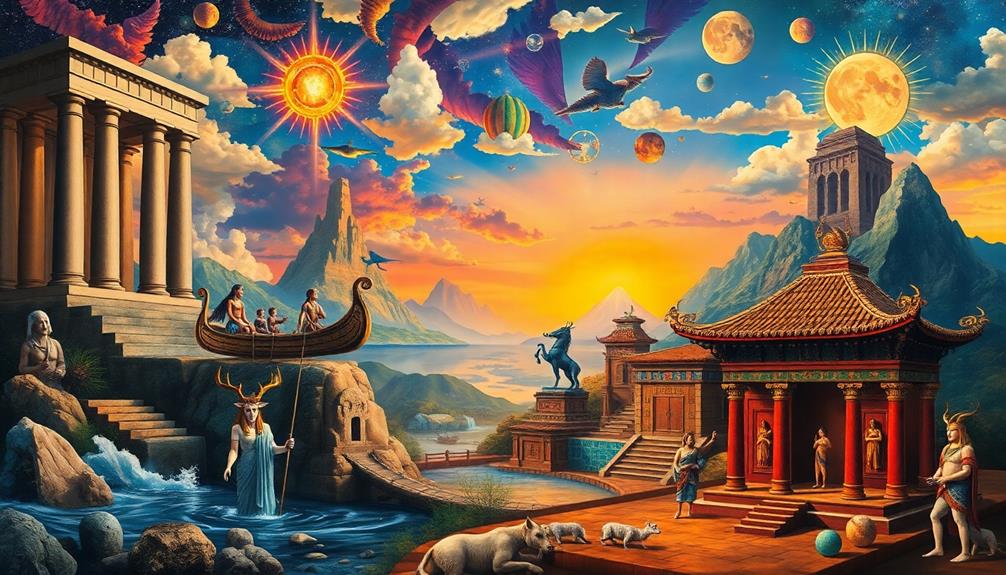
Afterlife beliefs and practices reveal fascinating similarities between Greek mythology and Hindu traditions. Both cultures feature deities overseeing the afterlife: Hades in Greece and Yama in Hinduism. These figures judge the souls of the deceased, reflecting a shared concept of post-death judgment. In Greek myths, Minos weighs the souls to determine their fate, while Hinduism teaches that one's karma influences rebirth or liberation.
The domains of the afterlife also mirror each other. The Greeks envision the Elysian Fields for the virtuous and Tartarus for the wicked, whereas Hindu beliefs include Swarga (heaven) and Naraka (hell), destinations influenced by one's actions.
Rituals for honoring the dead further highlight these connections. Greeks performed proper burials and offered gifts to guarantee safe passage, paralleling Hindu practices of cremation and shraddha rituals to honor ancestors.
Lastly, the symbolism of crossing water appears in both traditions. In Greek mythology, the river Styx serves as a barrier to the afterlife, while Hindus believe in crossing the river of life and death, symbolizing the shift to a new existence.
These afterlife beliefs intricately link these two rich cultural heritages.
Nature and Elemental Deities

Exploring the rich tapestry of mythology, we uncover a fascinating array of nature and elemental deities in both Greek and Hindu traditions. These divine figures evoke a deep connection to the natural world, reminding us of its power and beauty.
For instance, Varuna, the Hindu god of water, parallels the Greek god Anemos, who governs air and water elements. Similarly, Surya Deva, the sun god, is depicted riding a chariot like Helios, highlighting the sun's significance in both cultures.
- The nurturing essence of the earth, embodied by Prithvi and Gaia, comforts us like a mother.
- The roaring storms summoned by Indra and Zeus electrify our imaginations.
- Fire's sacred role, represented by Agni and Hephaestus, ignites our creativity and passion.
- Water's flow, controlled by Varuna and Anemos, reminds us of life's ever-changing nature.
- The sun's warmth from Surya Deva and Helios inspires hope and liveliness.
These elemental deities not only govern the forces of nature but also symbolize the deep respect both cultures hold for the elements that shape our world.
Moral Lessons in Stories
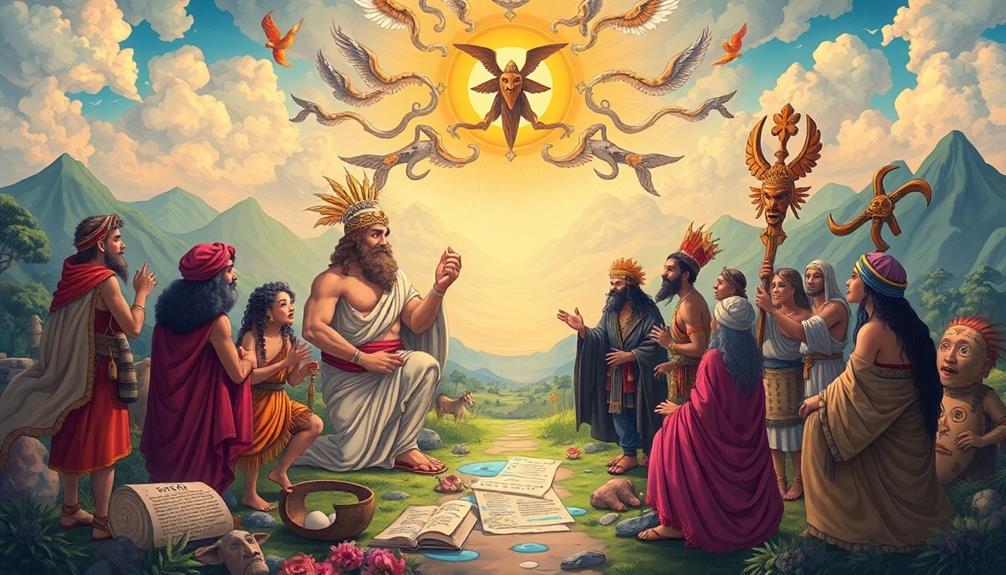
Throughout history, myths have served as powerful tools for imparting moral lessons, guiding individuals in their understanding of right and wrong. In Greek mythology, characters often face dire consequences that convey these lessons vividly.
Take Icarus, for example; his pride leads to his fall when he flies too close to the sun, teaching you about the dangers of overreaching ambition. Similarly, the tale of Pandora's box warns against unchecked curiosity, a theme echoed in other cultures. This cautionary approach to storytelling parallels the emotional regulation challenges seen in individuals with Borderline Personality Disorder, highlighting the consequences of impulsive behaviors and the importance of self-awareness.
In Hindu mythology, King Harishchandra's unwavering commitment to truth and integrity mirrors the Greek emphasis on honesty found in the story of Prometheus.
Then there's King Midas, whose greed turns everything to gold, serving as a cautionary tale against avarice, much like the tales of King Vikramaditya in Indian folklore.
Cultural Exchange and Influence

In ancient times, the exchange of ideas between Greek and Hindu cultures shaped their mythologies and religious practices. This cultural exchange allowed for the intertwining of beliefs, creating rich narratives that have endured through generations. You'd notice striking similarities, like the supreme triads of both civilizations, showcasing how deeply they influenced each other.
- Both cultures revered love, as seen in the deities Eros and Manmadha.
- The powerful narratives of Zeus and Brahma reveal shared archetypes among gods.
- Agricultural prosperity resonated through figures like Surya Deva and Helios.
- Universal themes of desire and passion echo across these mythologies.
- Educational disparities highlight the selective cultural awareness in modern times.
These connections illustrate not just shared stories but a profound human experience. The blending of these rich mythologies speaks to your emotions, reminding you that love, power, and the quest for understanding transcend borders.
As you explore these similarities, consider how cultural exchange continues to shape your own perceptions of myth and spirituality today, making you part of a larger narrative that spans across time and geography.
Frequently Asked Questions
Why Are Some Myths Similar in Different Cultures?
Some myths are similar across cultures because they reflect universal human experiences and concerns. People everywhere grapple with creation, morality, and the unknown, leading to shared themes that resonate deeply, regardless of geographical boundaries.
How Did Greek Mythology Influence Other Cultures?
Greek mythology's rich narratives and archetypes inspired various cultures, shaping their own myths. You'll find echoes of Greek gods, heroes, and themes in literature, art, and religious practices, reflecting a shared human experience across civilizations.
Why Is Greek Mythology so Similar to Hinduism?
You'll find Greek mythology and Hinduism share striking similarities due to common human experiences. Both feature powerful deities governing creation, love, and the afterlife, reflecting universal themes that resonate across cultures and time.
What Are the Similarities Between Greek Mythology and Indian Mythology?
You'll discover fascinating parallels between Greek and Indian mythology, like their supreme triads and heroic tales. Both cultures share themes of creation, preservation, destruction, and love, illustrating universal human experiences and values throughout history.
Conclusion
In exploring the striking similarities between Greek myths and those from other cultures, you realize that stories shape our understanding of the world. "All roads lead to Rome," and indeed, many mythologies converge on common themes and archetypes. These shared narratives not only highlight our universal human experiences but also remind us of the rich tapestry of beliefs that connect us across time and space. Embracing these parallels deepens our appreciation for the diverse ways we interpret life's mysteries.
